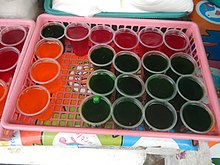food.wikisort.org - Dish
Gulaman, in Filipino cuisine, is a bar, or powdered form, of dried agar or carrageenan used to make jelly-like desserts. In common usage, it also usually refers to the refreshment sago't gulaman, sometimes referred to as samalamig, sold at roadside stalls and vendors.[1]
 A dessert made from leche flan and gulaman from Baliuag, Bulacan | |
| Course | Dessert |
|---|---|
| Place of origin | Philippines |
| Serving temperature | Cold |
| Main ingredients | Agar |
Description

Gulaman is the Filipino culinary use of agar, which is made of processed Gracilaria seaweed;[2] or carrageenan derived from other farmed seaweed species like Eucheuma and Kappaphycus alvarezii which were first cultivated commercially in the Philippines.[1][3][4][5]
It is usually sold dehydrated and formed into foot-long dry bars which are either plain or coloured.[6] It is also commonly sold in powder form.[7]
Uses
Gulaman bars are used in the various Filipino refreshments or desserts such as sago at gulaman, buko pandan, agar flan, halo-halo, fruit cocktail jelly, different varieties of Filipino fruit salads, black gulaman, and red gulaman.
Differences between gelatine and gulaman
The term gelatine (or "jelly") and gulaman are used synonymously in the Philippines, although they are very different products. While gelatine is an animal-derived protein, gulaman is a plant-derived carbohydrate[8] made from seaweed. This distinction makes gulaman suitable for those who may not eat gelatine for religious or cultural reasons, such as for Muslims or vegans.
Gelatine dissolves in hot water but boiling water is necessary to dissolve gulaman. Unlike gelatine which sets at refrigerator temperature, gulaman sets at room temperature. While gelatine can melt at room temperature, it is uniquely thermo-reversible[8] to its previous shape and form.
See also
- Chondrus crispus
- Kaong
- List of Philippine desserts
- Nata de coco
- Sago
- Tapioca balls
References
- Montaño, Marco Nemesio (16 September 2004). "Gelatin, gulaman, 'JellyAce,' atbp". PhilStar Global. Retrieved 10 February 2021.
- "Gulaman". Philippine Medicinal Plants. Retrieved 2008-07-07.
- Buschmann, Alejandro H.; Camus, Carolina; Infante, Javier; Neori, Amir; Israel, Álvaro; Hernández-González, María C.; Pereda, Sandra V.; Gomez-Pinchetti, Juan Luis; Golberg, Alexander; Tadmor-Shalev, Niva; Critchley, Alan T. (2 October 2017). "Seaweed production: overview of the global state of exploitation, farming and emerging research activity". European Journal of Phycology. 52 (4): 391–406. doi:10.1080/09670262.2017.1365175. ISSN 0967-0262.
- Impact Investment for a Business Venture for Community-Based Seaweed Farming in Northern Palawan, Philippines (PDF). Blue Economy Impact Investment East Asia & Partnerships in Environmental Management for the Seas of East Asia. 2017. Retrieved 8 February 2021.
- Habito, Cielito F. (1 November 2011). "Sustaining seaweeds". Philippine Daily Inquirer. Retrieved 8 February 2021.
- "Gulaman at Sago (Agar-Agar and Tapioca Pearls)". Lafang: a Pinoy food blog. 2006-07-13. Archived from the original on 2008-06-18. Retrieved 2008-07-07.
- "ZANG Gulaman". shireli.
- "Things you need to know about gelatine". Food Magazine-Philippines: 99. December 2006 – January 2007.
Другой контент может иметь иную лицензию. Перед использованием материалов сайта WikiSort.org внимательно изучите правила лицензирования конкретных элементов наполнения сайта.
WikiSort.org - проект по пересортировке и дополнению контента Википедии
